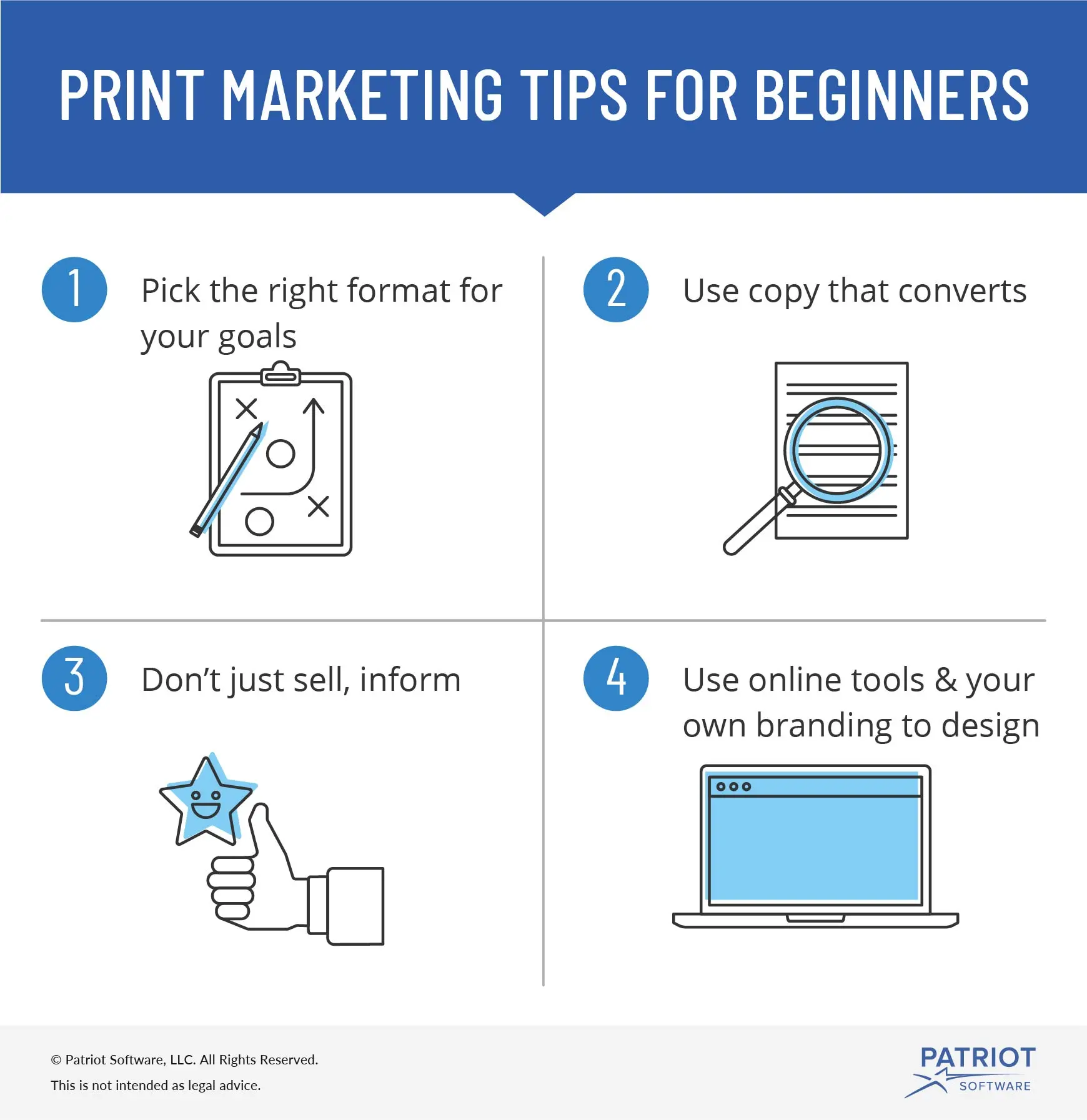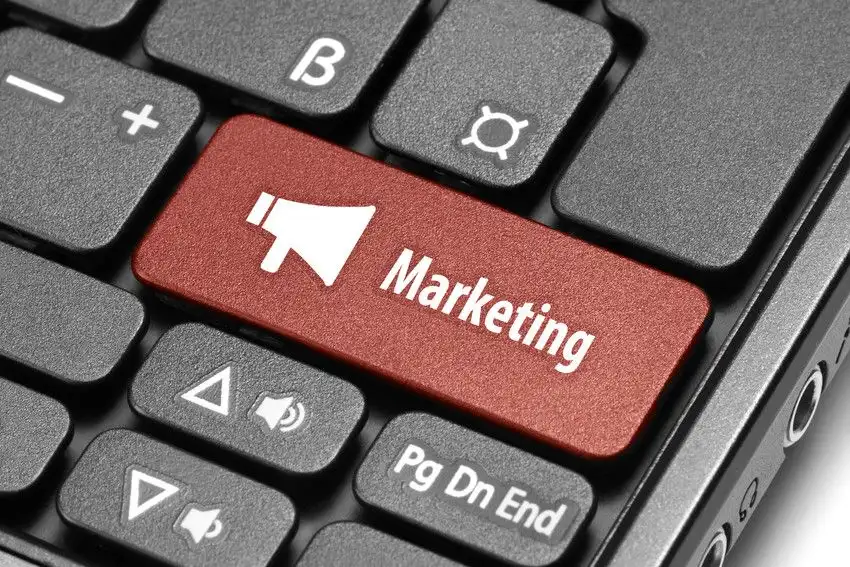Despite all the hype around online marketing, 85% of consumers said they’d be more likely to buy something from a business if it had professionally printed materials like flyers.
Why? Print marketing materials spark a feeling of psychological ownership—meaning people have stronger connections to things they can physically touch.
And while many small business owners assume consumers live in the digital world, traditional channels like mail catalogs are still where consumers are connecting to brands and making purchasing decisions.
The problem for small entrepreneurs is figuring out what type of print marketing they should be doing and how to leverage it effectively.
In this article, we’ll show you how to create effective print marketing materials that get more customers without tons of design know-how or money.

1. Pick the right format for your goals
Whether you choose to print brochures, flyers, or posters for your small business depends on your marketing goals and small business strategic plan.
Whatever format you choose, include a unique landing page URL on any printed material so you can track conversions (i.e. don’t just list your home page).
- For example: signup.mysmallbiz.com (instead of smallbiz.com).
Or, list a specific coupon code or a dedicated cell phone number.
Let’s explore your options:
Brochures
Brochures come in two formats: bi-fold brochures (fold in half) and tri-fold brochures (fold in three). Pick your format based on how much information you want to include.
Bi-fold brochures are best for including a unique call to action (CTA) on the outside and more detailed information inside.
Tri-fold brochures have the most versatile layout and allow for a lot of information and visuals. They’re compact and can be easily folded.
Either option works for trade shows, as consumers will be looking to buy and will want a lot of details about your company. Don’t forget to sign them up for your email newsletter at the booth so you can continue the conversation and reinforce the brochure’s information.
You might also want to include a referral offer, like a discount for every friend they refer to your business.
Flyers
Flyers are best when you want to focus on a specific selling point, like a sale or event.
Flyers use big headers that can be read at a distance. If you’re a local business, flyers are a good choice to leave at other shops where your customers are likely to visit.
Try hosting a class or event at your shop. If you’re online-only, partner with a local coffee shop or other retail space. Many community bulletin boards at libraries, adult education centers and colleges won’t want you posting promotional flyers, but they’ll be happy to let you post about your educational event.
Flyers are also great for networking events when you want to hand out something more detailed than company business cards.
Posters
Posters are perfect for small businesses because they’re usually cheap to print and very noticeable. They’re easy to design and can be printed in different materials.
Place your creative posters in your shop windows or around town. Partner with other local businesses to do poster exchanges.
The trick is finding out where your potential customers shop. For example, if you do nutritional coaching, your potential clients probably frequent local gyms or specialty food shops.
2. Use copy that converts
Keep your copy clear and simple. Even if you’re using a tri-fold brochure format with lots of space for words, keep your message short.
Copy should focus around a:
- Unique value proposition
- Compelling call to action
- Brief explanation of your services or products
Here are some quick tips to write copy that converts:
- Use a headline that makes it super clear what your company does.
- Summarize your services via bullet points (or use icons instead!) for maximum impact. Focus not on vague deliverables like “SEO optimization” but clear value propositions, such as: “We optimize your brand’s online performance.”
- Your body copy (if there’s room) should clearly outline your business’s story or anything else that sets you apart.
- Body copy is a great place to include client testimonials. Ask clients to include specifics: metrics that went up, increased revenue, etc. Think “My YouTube views went up 30% in one month” not “I have so many more visitors to my YouTube channel.”
- Your CTA should be not only be highly visible but also explicit. Tell readers exactly what you want them to do. For example, “Call to book your appointment with an expert today” is very clear.
In short: your copy shouldn’t try to do and say everything. It should share just enough and use bold headers and design to maximize what gets remembered by potential customers.
3. Don’t just sell, inform
Using print materials to list your services or products and prices might seem like a good idea.
But, showcasing your company and what it’s all about can be much more effective in the long run. It helps the potential customer connect to you and makes you more memorable than all that other sales-y, pushy marketing copy out there.
Instead, try using your print marketing materials to share:
- How your small business runs
- What types of problems you solve for customers/clients
It’s a much better way to build trust.
4. Steal these (simple) design secrets
Thankfully, you don’t need to be (or hire) a designer to make impressive print marketing materials anymore.
Online tools make good design accessible to freelancers, consultants, and small business owners alike.
Here are 5 design secrets even complete newbies can use:
1. Use high-quality stock photos
You don’t need to purchase them, either. Some websites offer thousands of free, professional stock photos you can download and use.
2. Use your own photos
Photos of your business, staff, or office can make an even greater impact than even the most stunning stock photo. Your own photos are likely to be more relevant and personable. Just make sure they’re high resolution—they should never be pixelated or fuzzy.
3. Use your branding
Pick your brand colors and design a simple logo yourself. Many free online design tools will import and apply your branding with one click. It’s an easy way to adapt an existing template.
4. Use large, attention-grabbing headers
No matter what print format you’re using, you still want people to see it from a distance. Be bold and use oversized text.
Try applying it to your slogan, list of services, or call to action.
Large headings make it clear what the focus of each page is. Your call to action and slogan should also stand out.
5. Use icons instead of bullet points
Icons are a great way to reinforce your point and organize information.
Use them when listing your services, instead of resorting to tired old bullet points.
Icons are a fresh, modern way to spice up your print advertising and will appeal to visual learners.
The takeaway
As more small businesses throw money solely at digital marketing, be a renegade and focus on incorporating print marketing into your strategy.
The key is to pick a format that works for your business: whether you appear frequently at trade shows or events, whether hosting educational classes is a good fit for your company, or if you’re a local business that can easily partner with other local outfits.



